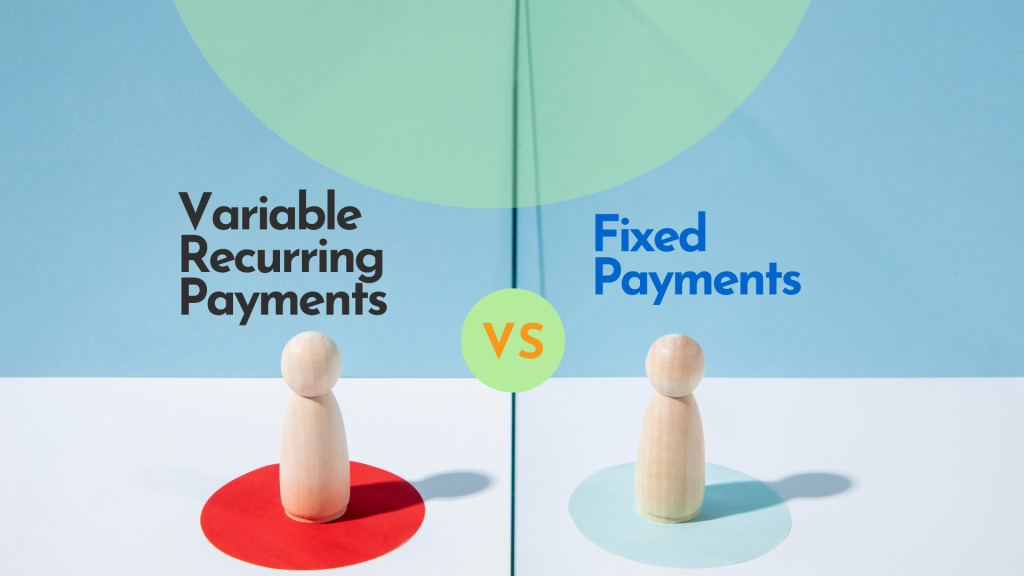Comparing Variable Recurring Payments and Fixed Payments
There are two primary options for resolving long-term financial arrangements: Variable Recurring Payments (VRP) and Fixed Payments (FP).
The emergence of VRPs has revolutionised the financial ecosystem, encouraging innovation and product development and offering new opportunities for consumers, merchants, and banks to build more sophisticated relationships.
There are advantages and disadvantages when comparing Variable Recurring Payments to fixed payments – let’s consider these here.
Variable Recurring Payments can fluctuate, linked to commercial interest rates or other market factors.
The most common examples of Variable Recurring Payments include tracker mortgages, utility bills, and personal credit cards.
These enable customers to benefit from lower payments by reducing consumption or lower interest rates when adjustments occur.
But it could understandably be assumed that VRPs would expose consumers to higher payments if rates rise. However, one b the most significant advantages of this payment innovation is that with VRPs, customers can cap the maximum amount consented to be collected under the same mandate. This gives businesses the opportunity to offer customers greater control over their finances, ensuring unmatched peace of mind and financial security compared to Direct Debits.
As the name suggests, fixed payments, including direct debits and standing orders, remain constant during the agreement between the financial institution and the customer.
Fixed-rate mortgages and instalment plans provide clarity and consistency in budget planning. While the amounts are not expected to fluctuate, they can still be collected via Variable Recurring Payments (VRPs) as an alternative to traditional payment methods.
When comparing VRP vs FP, borrowers must balance risk and reward against stability and predictability.
Understanding Variable Recurring Payments (VRP)
Simply put, a Variable Recurring Payment (VRP) is a financial instrument with flexible payments that can fluctuate in value or frequency, enabled by financial APIs.
Utility payments or subscription fees for services can be adjusted to match actual consumption so customers can control their expenditures more efficiently.
When agreed, VRPs also enable greater flexibility in payment schedules (weekly, monthly or quarterly). Still, there are some important issues to consider.
Both parties need to recognise the risks connected to variable payments.
The payer must monitor their exposure to fluctuations in outgoings and have sufficient funds to settle their invoices.
Equally, the payee must clearly communicate changes in billing values and remain responsive to requests for pricing information from the payer.
Accurate record-keeping maintains trust and confidence for all parties, enabling a dynamic and flexible approach to managing repeating transactions.
Understanding Fixed Payments
By contrast, fixed payments are regular and unchanging transactions that do not fluctuate over an agreement period.
While not as adaptable or responsive as VRPs, fixed payments have advantages for both parties in a financial transaction.
When comparing Variable Recurring Payments to fixed payments, many prefer the predictability and stability of fixed costs, providing a reliable income stream and financial certainty for all parties.
Personal loans, lease payments, insurance premiums and entertainment subscriptions are typical examples of fixed payment transactions.
The simplicity of fixed payments is attractive for those who need to carefully budget and plan their finances. This also applies to pension and annuity payments for retirees.
Fixed payments are also subject to potential adjustments, including interest rate changes, which must be considered when comparing the merits of VRP vs FP.
Key differences between Variable and Fixed Payments

What are the fundamental differences between Variable Recurring and Fixed Payments?
Fixed payments are constant over the life of the agreement, with debits and charges confirmed at the outset.
Variable Recurring Payments can fluctuate as interest rates rise or fall or if other market conditions require an adjustment to the charges.
When comparing Variable Recurring Payments to fixed payments, payees consciously choose between certainty and uncertainty.
Fixed payments offer a stable financial platform for payees, safe in the knowledge that their personal expenditure can be projected far in advance.
Choosing a VRP solution reflects a desire for potential short-term savings in monthly outgoing payments while acknowledging the risk of higher rates if circumstances change.
In a volatile economic environment, the “risk/reward” of VRP vs FP decisions has become notably more significant, as interest rates and market conditions are subject to frequent change.
When to use Variable Payments vs Fixed Payments
Variable Recurring Payments are best suited to situations where manageable risk is tolerable, enabling greater flexibility and adaptability for creative financial solutions.
If individuals perceive that lower interest rates are likely in future, variable interest rate loans offer better value than a fixed rate product.
Variable payments for entertainment services subscriptions may offer greater value, enabling users to manage their expenditures more fairly.
Variable Recurring Payments (VRPs) are best suited for individuals or businesses seeking:
- Predictability and greater control
- Convenience
- Improved money management and cashflow
When it comes to managing payments, VRPs stand out for their flexibility and adaptability, offering users the ability to adjust payments according to their evolving needs and circumstances. This feature empowers individuals to maintain better control over their finances, ensuring that payments accurately reflect their actual usage or consumption. Moreover, VRPs contribute to financial inclusion by offering tailored payment solutions that cater to individual preferences and circumstances, thus ensuring accessibility for all.
In contrast, fixed payments may provide a sense of stability and predictability, which some consumers prefer in their financial planning and budgeting. However, VRPs offer a more modern and versatile approach to managing recurring transactions, accommodating the diverse needs of users while promoting greater financial empowerment.
While fixed payments are suitable for those who prioritise familiarity and invariability in their financial arrangements, VRPs offer a dynamic solution that adapts to changing circumstances. Whether it’s for mortgages, subscriptions, car payments, personal loans, lease agreements, insurance premiums, or equipment rental, VRPs provide an alternative that aligns payments more closely with individual financial circumstances.
Ultimately, VRPs offer a forward-thinking approach to financial management, empowering individuals to navigate their financial obligations with greater flexibility and control.
Conclusion
The growth of Open Banking innovations, enabled by financial APIs and regulated by the PSD2 directive, has delivered creative payment solutions that benefit consumers and their financial services providers.
Comparing Variable Recurring Payments to fixed payments, individuals and institutions now have greater choice, flexibility, security and transparency in resolving long-term financial arrangements.
Consumers can choose the terms that suit their circumstances, comparing the benefits of VRP vs. FP arrangements in a more competitive, flexible and dynamic market.
Comparison table of Variable Recurring Payments (VRP) vs Fixed Payments
In the comparison table below, we explore the key features, advantages, and considerations of both VRPs and Fixed Payments.
| Aspect | Variable Recurring Payments (VRP) | Fixed Payments (FP) |
| Use Cases | Subscriptions, automated invoicing, Recurring billing, smart meters, e-wallets and pre-paid cards auto top ups, utility bills, credit cards repayments, charity donations. | Direct debits, standing orders, card-on-file, fixed-rate mortgages |
| Flexibility | Allows for adjustments based on consumption | Payments remain constant throughout the agreement |
| Advantages | Adaptability: Dynamic payments adjust to user needs. Flexibility: Customisable schedules and amounts. Cost-effectiveness: Saves money for businesses and customers. Convenience: Streamlines payment processes. Customer-centric: Prioritises customer needs. Simplicity: Easy and straightforward payment management. Personalisation: Custom features for users and businesses. | Immutability: Consistent payment amounts over time. Predictability: Known payment schedules and amounts. Simplicity: Straightforward payment management. |
| Disadvantages | Moderate to low awareness: As a recent payment innovation, VRPs may suffer from low awareness among consumers, hindering their adoption despite their innovative features. Market availability / adoption: VRPs require broader acceptance and adoption to realise their full potential as a payment solution. | Lack of responsiveness / Limited flexibility: Fixed payments may lack the agility to adapt to changes in users’ financial circumstances or preferences, resulting in a less dynamic payment experience. Disjointed user experience (UX): with payment screens typically hosted through a third-party website, offering limited to no branding options. Redirects associated with this process can disrupt the user experience and interrupt the payment flow. Limited responsiveness and flexibility: fixed payments offer little room for adjustment in response to changes in financial circumstances, potentially hindering users’ ability to adapt their payment schedules to suit their needs. Reduced potential for cost savings: due to their inflexible nature, fixed payments may limit users’ ability to optimise their expenses or take advantage of cost-saving opportunities. Costly: fixed payment structures can be costly for businesses to maintain, especially if they require additional resources or incur penalties for missed or late payments. |
| Mandate Setup | Instant setup, takes only minutes to establish | Typically require more time to set up usually 7-10 business days |
